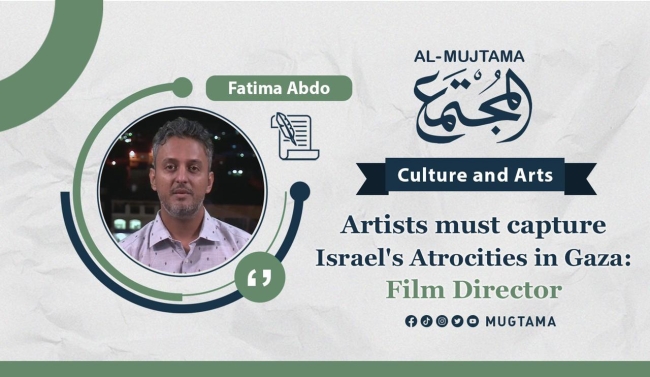Artists must capture Israel's Atrocities in Gaza: Film Director Featured
-------
Culture and Arts
In light of the ongoing events and the continued violations by the Zionist occupation in the Palestinian territories, especially in its war on the Gazan heroes and the ongoing suffering of the people due to these atrocities, attention has turned to the role of art as an expressive tool and a means of documentation in highlighting the violations of the maniac occupation and depicting the painful humanitarian reality in the occupied territories, expressing rejection of the occupation, and supporting the Palestinian people in their struggle.
In our interview with the Yemeni writer and director Marwan Mafraq, we discussed the impact of the events in Gaza on artistic and dramatic production in Yemen, especially since it holds a central place in the conscience of Arabs.
Palestinian resistance has inspired a rich tapestry of art and culture
First, did the events in Gaza revitalize the artistic community's engagement with Arab world issues, particularly the Palestinian cause?
Despite the significant impact of the civil war in Yemen on our people in general and its artistic elite in particular, the national sentiment towards the Palestinian cause is deeply ingrained in our consciousness. What is happening in Gaza currently renews and strengthens this sentiment. However, there appears to be a significant lack of dramatic production addressing the Palestinian cause. Some efforts are limited to theatrical works. Nevertheless, I am optimistic about the possibility of producing high-quality and substantial dramatic works in the future.
While artistic work in Yemen lags behind in terms of progress in artistic production due to the ongoing civil war, there has been a strong and continuous commitment by Yemenis to support the Palestinian cause for decades. They support the Palestinian people in their struggle to achieve their legitimate rights and end the Israeli occupation, which has committed numerous massacres and crimes.
Given the devastating human cost of the ongoing conflicts in Yemen and Palestine, can art be used to capture and convey their shared suffering?
Through our cinematic works, we addressed the effects of wars and noticed that these effects are similar on any land and in any country. Our comprehensive portrayal of these devastating consequences resonates deeply with audiences, particularly those who have experienced the horrors of war firsthand, such as the people in Palestine, Syria, and Iraq. This confirms that the language of art in television drama and cinema is universal, as our works blend art and humanity to capture the ongoing impacts of war in a compelling and engaging manner.
There are many stories, visual or written, that depicts the tragedies of the Palestinian people, each of which can serve as a standalone dramatic work. Can these stories be used as the basis or inspiration for locally or regionally produced dramatic or artistic works?
For 75 years, the Palestinian people have narrated stories of their courage and resistance against the “Israeli” occupation. Their impactful and numerous stories we have witnessed and heard during this period showcase the bravery of these resilient people, in addition to the grave crimes against them committed by the occupying forces.
This history, rich with humanity and resistance, serves as a source of artistic and historical wealth. Through it, we can produce various artistic works in the fields of television drama and cinema.
It is the responsibility of artists and drama creators to use this rich cultural heritage. They should not forget their significant role as conveyors of artistic and humanitarian messages, bearing the weight of this responsibility seriously.
Artists must not forget their role in supporting Palestine and “Al-Aqsa”
The current “Israeli” aggression on Gaza has created the largest platform in the history of this nation for producing diverse dramatic works to express it, especially the killings and decapitations of children in homes, streets, and hospitals. The destruction of homes with people inside and the dismemberment of individuals from under those explosions, the starvation war, and the forced displacement of people from their neighborhoods under bombardment—all these scenes cannot be overlooked by any artist or drama writer. They must engage with them, produce them, and present them in an impactful artistic form for the Arab audience and for historical documentation.
Social media has forced new forms of artistic expression. Has it replaced television dramas?
Social media has become an integral part of our daily lives, and despite the widespread presence of art on these platforms, it cannot completely replace television drama in our current time. The differences lie in the standards and artistic effectiveness, and the tangible impact of television drama remains significant.
Through television drama, we experience a deeper connection with stories and characters, offering diverse and profound insights into various topics and issues. Drama allows a greater embodiment of the human spirit, enhancing understanding and emotional engagement in innovative artistic ways.
Amid rapid changes in media, the artistic impact of television drama remains prominent and holds special importance in shaping perspectives and influencing culture.
In this crucial time, we must channel this impact strongly toward raising awareness about the primary Arab cause, which occupies a central place in our hearts and souls. Activating art in this context requires serious consideration of how to effectively contribute to conveying our message and influencing public awareness regarding these vital issues.
Drawing inspiration from the suffering of the Palestinian and Yemeni people in artistic works
Does modern media drama (social media) pose a threat to traditional drama?
Our need for balanced drama that varies between television and modern media art is evident. Technological advancements can contribute to improving the drama industry, making it more attractive to youth and those who seek continuous development.
Modern media drama is often produced by non-specialists, leading to a loss of content and a weakness in presentation. In contrast, television drama relies on meticulous and comprehensive scrutiny to ensure that the message reaches the audience fully and completely.
How can a Yemeni director or actor contribute through drama to preserving Yemeni cultural identity?
The selection of compelling themes or issues that resonate with the essence of our culture is fundamental to preserving cultural heritage and identity through drama.
Additionally, several tools contribute to this task, such as filming locations that reflect the beauty and diversity of our environments, clothing that plays a crucial role in portraying cultural heritage, and the use of dialect, which is a powerful means to convey the authenticity of the language and its expressions.


